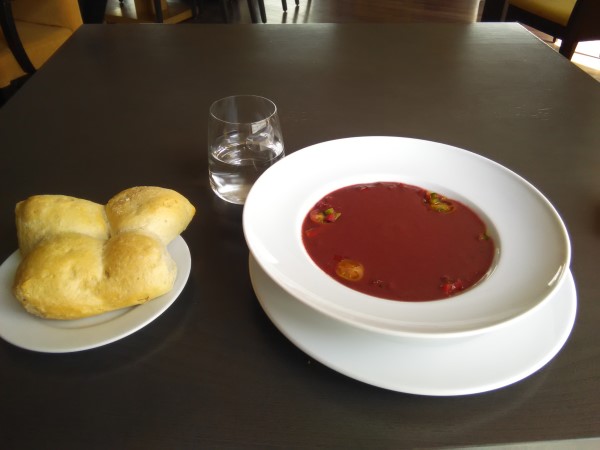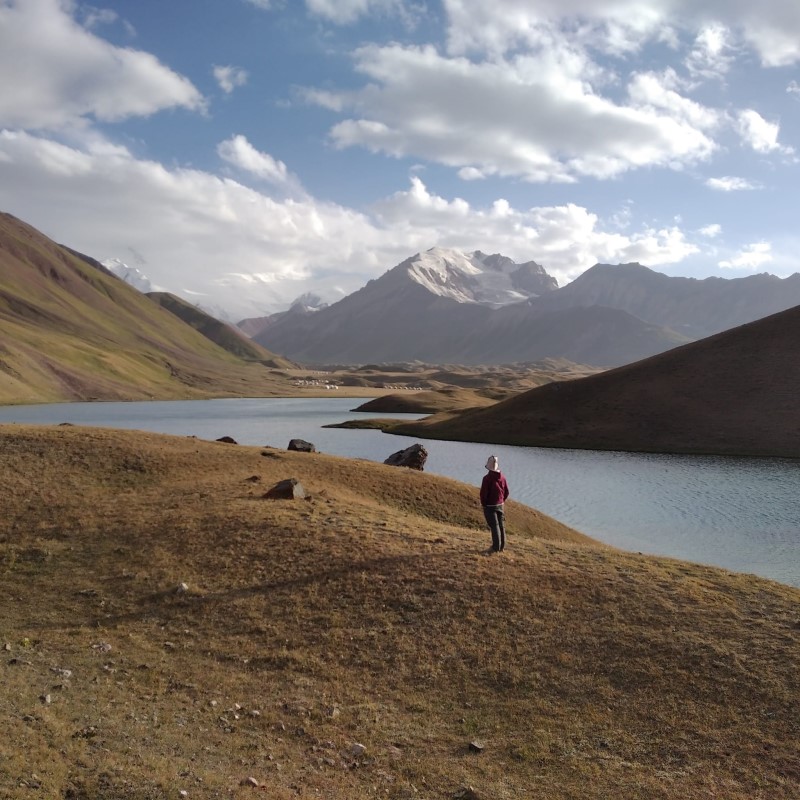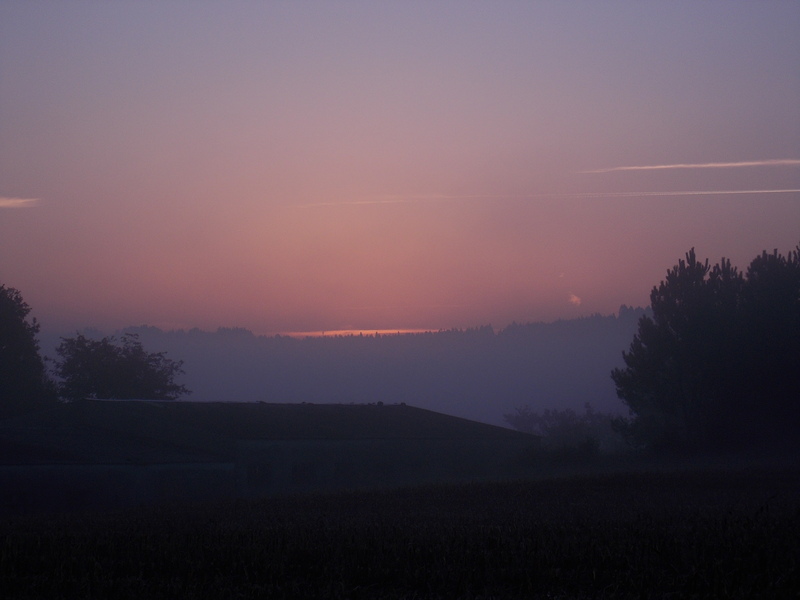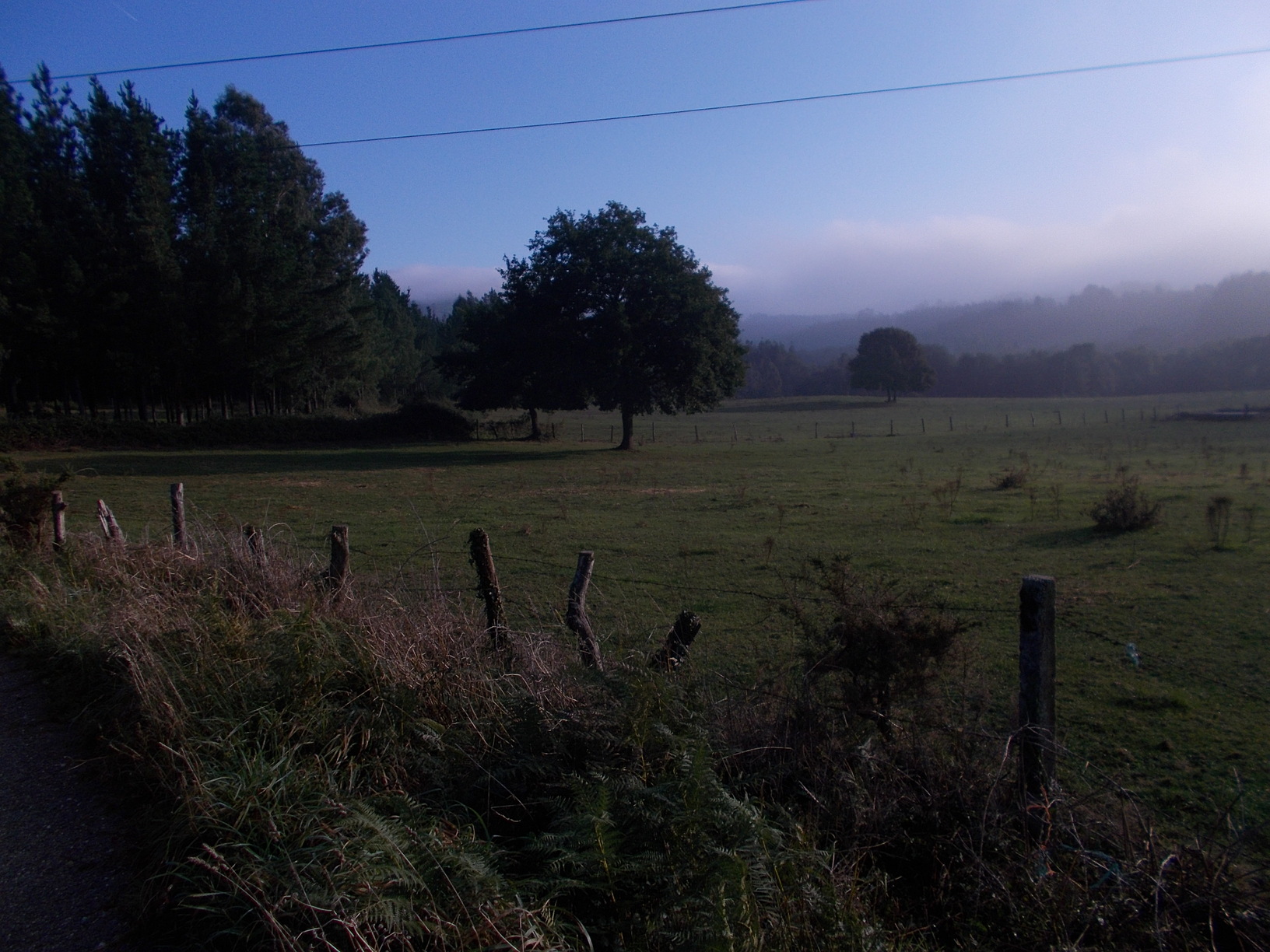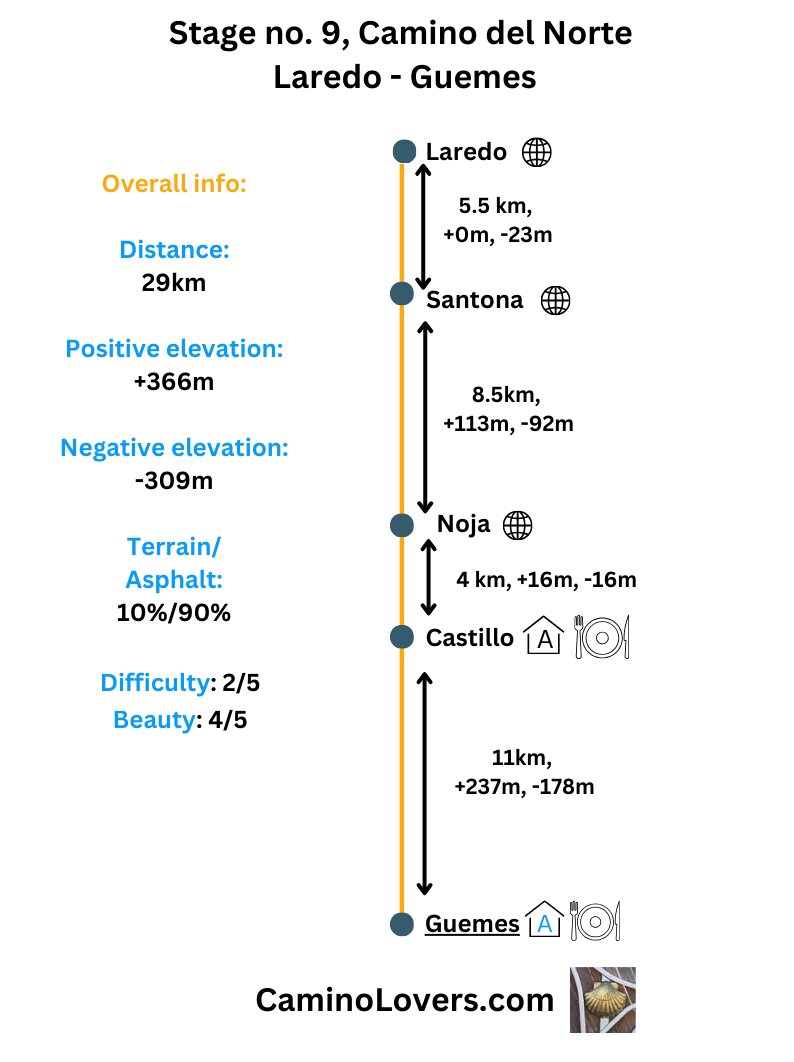
Basic Details
- Starting point: Convento de las Trinitarias, Laredo (convent, the only pilgrim albergue in Laredo and a place where most pilgrims stay in the town).
- Ending point: Albergue de Abuelo Peuto, Guemes (one of the top 3 most famous albergues on all Caminos in Spain, definitely a must stay while you do the northern route).
- Availability of alternative routes: Not really. There is an alternative route marked in the interior, but this meant only for cyclists, since the short part of the trail between Santona and Noja is virtually impassable for cyclists. It is a steep climb with a lot of plants, and it gets extremely muddy after any rain (and this is the most humid part of Cantabria, so it rains often here). For hikers it is totally okay, and for some experienced mountain bikers with no luggage it is passable, but for a typical pilgrims with his bags and stuff it just isn’t a Camino for bikes. The interior route isn’t worth taking for pilgrims without a bike, hence we are not covering it in this guide.
- Distance: 30 km (download GPS here).
- Elevation difference: +366m, -309m
- Link to online map: here.
- Difficulty score: 2/5
- Beauty score: 4/5
- Terrain/asphalt: 10%/90% (yeah, too much asphalt, I know :)).
- Next stage: Camino del Norte stage no. 10, Guemes – Santander.
- Previous stage: Camino del Norte, stage no. 8, Onton – Laredo.
Elevation profile for the route
 – Except of the short technical part between Santona and Noja (km 9 to 11 on the chart), the gradient isn’t really steep, which makes from this stage one of the easier ones on Camino del Norte. Still it is 30km of walking, and it rains often in this part of Spain, so while not steep it isn’t super easy either.
– Except of the short technical part between Santona and Noja (km 9 to 11 on the chart), the gradient isn’t really steep, which makes from this stage one of the easier ones on Camino del Norte. Still it is 30km of walking, and it rains often in this part of Spain, so while not steep it isn’t super easy either.
Advanced info about the stage
- Trail marking: Still far from ideal, as is the case generally in the province of Cantabria (hopefully someone from the local government reads this post and it motivates them to make it better :)). I recommend downloading our GPS file for the stage, and follow it on your favorite device. Of course, you can also use an app like Buen Camino (or a similar one) for navigation.
- Alternative route info: This isn’t really an alternative route, but an additional circuit around the coast of Santona (ancient forts, two lighthouses, one of them incredible, with a descent-and later an ascent-of 763 stairs of stones, and so on). In my opinion if you’re not in rush on your Camino it is a circuit worth taking. We have a separate page dedicated to it here: Laredo – Santona, over the Faro de Caballo, with GPS, pictures, videos and everything you need to know to enjoy this way.
- Natural places worth seeing: The nicest part is definitely the small hill between Santona and Noja, called “Colina el Brusco“. Not only it passes through pristine nature, it also offers beautiful views, especially on the marvelous beach of Noja (Playe de el Brusco). But even before that you will pass over the beach of Santona (Playa de Berria), which is extremely pretty as well, with green hills on both sides of the beach. Both beaches (and the hill in between them, the one you will walk over) belong to the natural reserve Parque natural de las Marismas de Santoña, Victoria y Joyel. It is one of the most humid zone of entire Cantabria (yeah, it rains quite often there), and you can spot all sorts of animals and birds if you’re lucky. It is especially common to see huge flocks of birds, sometimes stretching over kilometers on the sky, which is a spectacle hard to forget… Hence you should definitely not rush doing this part of the walk.
- Historical, architectural, and culinary places worth seeing: Let’s start with a culinary treat this time. The tuna fish of Santona (bonito de Santona) is renowned in entire Cantabria and beyond. The season for fishing tuna in this part of the Northers coast is between June and October (can change slightly depending on the water temperature), and especially between July and September you can see it offered as a specialty in any good restaurant in the zone. It is typically served with a tomato sauce, and if you eat fish, it is a must try! When it comes to historical & architectural places, Santona is the winner one more time, with it ancient forts (dating back to 17th century). The most interesting one is the fort of San Carlos but others are also worth a visit for any history lover. If you’re into history, I recommend you making an extra circuit over these forts in Santona. We have a special page dedicated to the circuit here. Besides Santona, the albergue in Guemes (the suggested endpoint of this stage) is itself pretty interesting from both historical and architectural point of view. An isolated complex of building offers plenty to marvel on, not only when it comes to numerous photographs on the walls, documenting the life of the founder of the place and its history.
- Camping/bivouac options on this stage: Far from ideal when it comes to wild camping, with an exception of the zone of Guemes. However, since Guemes is a donativo albergue, it doesn’t really make much sense camping nearby. If you camp because you want to save money, you can just stay in Guemes and make a symbolic donation only (of course if you can afford it, make a proper donation to support this great place). Preferring to stay closer to the beach, you have six good organized camping alternatives, one in Santona, and an astonishing five in Noja. I will list the one in Santona and the two best in Noja (from pilgrim perspective). There is also one camping in the interior, in a more quiet and natural location. I will list that one as well.
- Camping Playa de Berria (Santona): Right on the Camino, great surfing beach, old facilities, prison in the neighborhood, price very reasonable (one of the least expensive camping places on the entire camino).
- Camping Suaces (Noja): 2km detour from the Camino (all camping places in Noja require making a detour, so this isn’t really such a big minus), clean, pilgrim friendly, dog friendly, right on the beach.
- Camping Argos (Noja): 1.5km detour from the Camino, new and clean, you need to walk about 10 minutes to the beach, all facilities, price for two pilgrims with a tent and electricity about 25 euro.
- Camping Los Molinos de Bareyo (Bareyo): Right on the Camino, pilgrim friendly, dog friendly, nice views and nature, decent facilities, very quiet and relaxing, just 4 km before Guemes.
- Dog friendly score: 4/5. Quite good for dogs, despite the overwhelming asphalt walk. Even when on asphalt, however, the roads the Camino follows are very quiet with minimum of traffic. You have plenty of shade too, especially once you leave the coast. The worst part for dogs is the crossing of Santona, but it isn’t particularly long. Some dog friendly accommodation options along the way, including the ending point (Guemes), or the camping in Bareyo. Water fountains on the way.
- Special remarks: To get from Laredo to Santona you have to take a boat. The first boat leaves at 9am (something to take into consideration) and the last one at 6pm. The price is 2.50 euro, you’ll have to pay an additional fee of 2 euro for bike. It is a short crossing and it takes just about 5 minutes. If you’re a die-hard pilgrim, and do all you can to avoid boat crossings, you’ll have to walk about 3 extra kilometers, on a road pretty busy with cars, to get to a bridge crossing between Colindres and Adal, called the Bridge of Treto. I do not recommend this option, unless you want to leave Laredo super early (like at 6, and do not want to wait 3 hours for a boat), or you are on bike and on budget, and those 5 euros you’ll save make a difference to you. Of course some extra kilometers on bike (and on the road) are never as bad as doing the same thing walking…
Accommodation options on today’s stage
* The infographic displays the number of pilgrim hostels (only pilgrims allowed), hostels (anyone allowed, shared rooms), and other accommodation options (hotels, pensions, etc, private rooms) in each point along the route, together with price range. For exact explanation of the pictograms we use check the explanations page. Below the infographic you will see our recommended picks (up to 3 pilgrim options and 1-2 “privacy” options, maximum five) for the stage, together with important information (but not too much info, just what you need :-)).
Recommended places to sleep along this stage
Pilgrim options:
- Albergue Hospital de Peregrinos, La Isla (km 20, a detour, therefor not on the infographic). Location and reviews on Google maps here. People walking through La Isla stay more on the coast and actually do not go to Guemes at all. I have to add this way as another alternative camino route (yeah, there’s still some work to do on this website :)). Anyway, I wanted to mention the albergue here, since it has excellent reputation across all platforms, almost never gets full (because of the location), and it is in wonderful surroundings. 28 beds, 10 euro/bed, extra payment for dinner/breakfast, accepts pilgrims with dogs. Check-in from 3pm to 10pm. Recommended way of reservation: by phone, +34 658 547 270, or +34 660 293 057.
- Albergue La Cabaña del Abuelo Peuto, Guemes (km 29). Location and reviews on Google maps here. A legendary albergue, and a place where they never send anyone away. Open all year long, officially they have 70 beds but they will find a place for more pilgrims if needed. Donation based. The person in charge, Padre Ernesto, now well in his eighties, is a very interesting person and it is his lifetime work that makes this place so special. He still gives a one hour long speech before dinner every day, and it is an interesting one indeed. Also every year, from all albergues on Camino del Norte, Guemes records the highest numbers of pilgrims. All in all highly recommended for an experience. Reservations are not allowed, and they aren’t needed here…
Privacy/luxury options
- Hotel Las Torres, Castillo (km 19). Reviews and location on Google maps here. A very nice family-run hotel, frequented by pilgrims, especially couples. High reviews across all platforms. Early check-in time for Spanish standards (from 1pm), prices start at 80 euro/room, can go up to 100 euro in the high season in the summer. A nice place for anyone seeking a bit of privacy outside of both the coastal and the camino buzz… Recommended way of making a reservation: booking.com.
Pictures from the stage
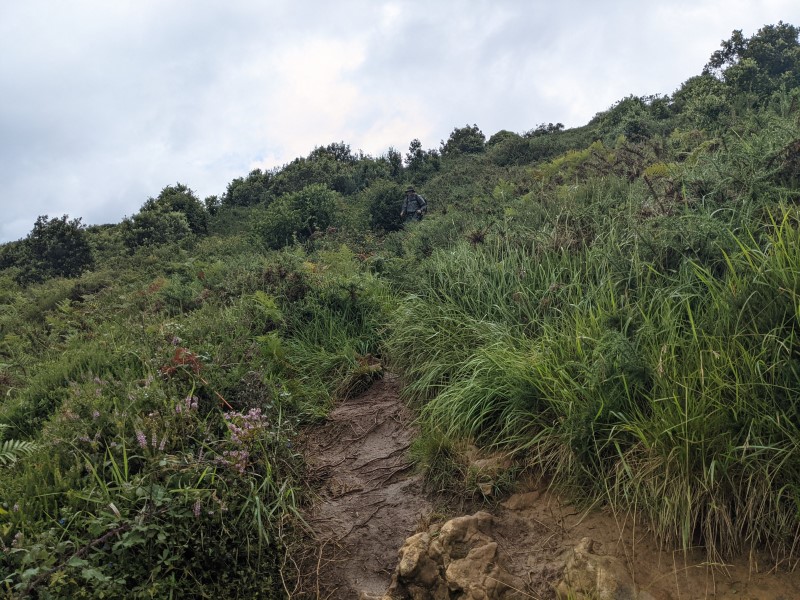 – The steep and muddy part from Santona to Noja. The steep part is short (just about 1km both descent and ascent), but can be tricky for someone with bad shoes or lack of hiking experience, especially in rainy weather.
– The steep and muddy part from Santona to Noja. The steep part is short (just about 1km both descent and ascent), but can be tricky for someone with bad shoes or lack of hiking experience, especially in rainy weather.
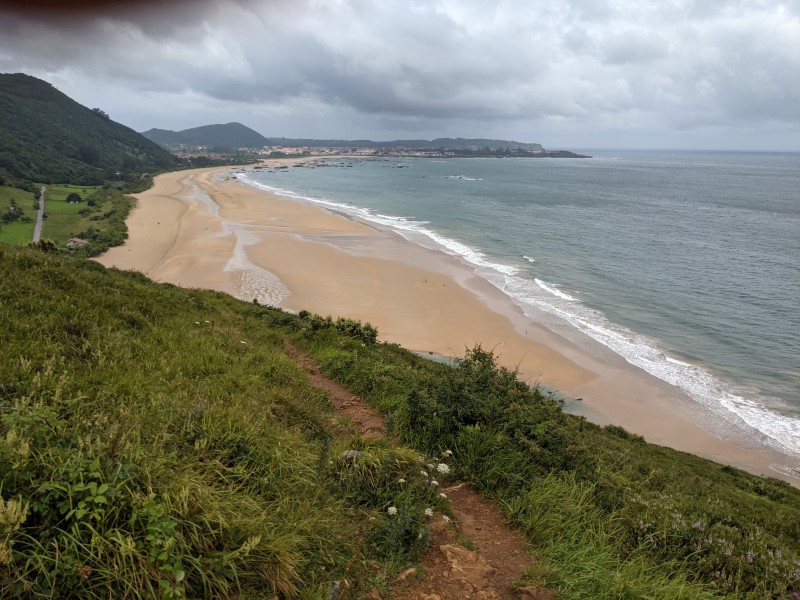 – The beach of Noja, quite popular with surfers. You can either walk on the beach (a recommended option), or you can walk on a path that is visible on the left side of the picture.
– The beach of Noja, quite popular with surfers. You can either walk on the beach (a recommended option), or you can walk on a path that is visible on the left side of the picture.
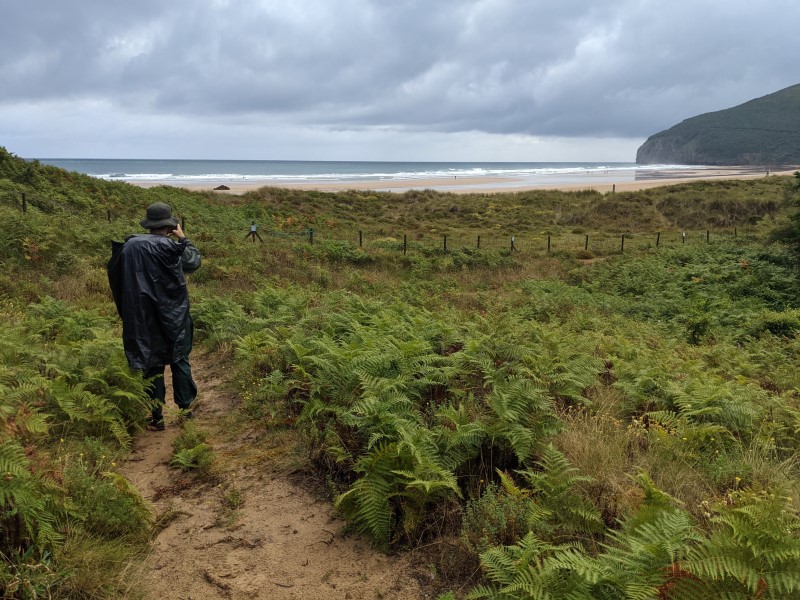 – Rain poncho comes handy on a day like this…
– Rain poncho comes handy on a day like this…
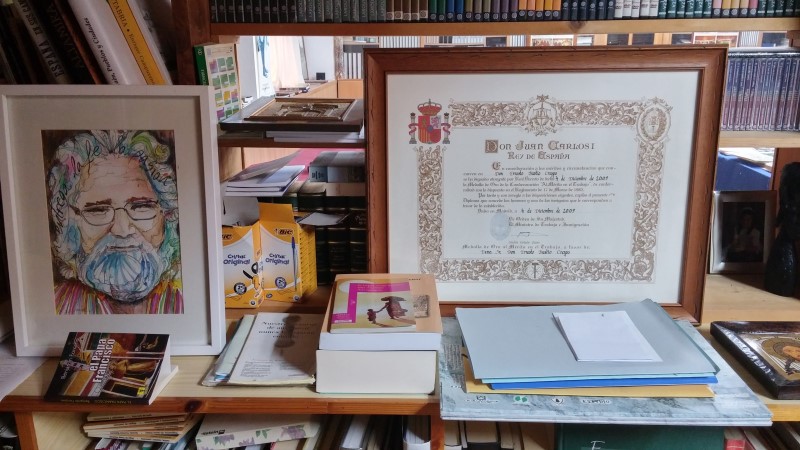 – A picture from the library in the albergue in Guemes. One can spend hours just walking around the place (it is really big), checking the books, the pictures, the paintings, and everything this place has on display.
– A picture from the library in the albergue in Guemes. One can spend hours just walking around the place (it is really big), checking the books, the pictures, the paintings, and everything this place has on display.
Few tips at the end
- If you decide to sleep in Guemes (which I highly recommend), you do not need to worry about getting the bed. The official capacity of the albergue is 70 beds, but they won’t send anyone away, and will find a place for you, even if more than 100 pilgrims stay on a night (yep, such nights do happen in Guemes).
- There is a special circuit you can make around Santona, going to one of the most magical places on the entire Northers coast, the Faro de Caballo (descending 763 stone stairs), and passing through several ancient forts (some are in decent conditions, some are just ruins). We have a special articles dedicated to this circuit, and you can check it out here. If you decide to make this circuit, I recommend you to do not continue farther on the day, and simply sleep in Santona (after completing the circuit, which takes about 4-5 hours). There isn’t a pilgrim albergue in Santona, but there is a youth hostel for a great price (below 10 euro), and other accommodation options in the town.
Next/Previous Stage
- Next stage: Camino del Norte stage no. 10, Guemes – Santander
- Previous stage: Camino del Norte, stage no. 8, Onton – Laredo




![Ultralight Packing List for Camino de Santiago [2025 Edition]](https://caminolovers.com/wp-content/uploads/2022/03/altra-shoes-640-x-480.jpg)
